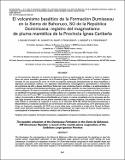Por favor, use este identificador para citar o enlazar a este item:
http://hdl.handle.net/10261/156912COMPARTIR / EXPORTAR:
 SHARE SHARE
 CORE
BASE CORE
BASE
|
|
| Visualizar otros formatos: MARC | Dublin Core | RDF | ORE | MODS | METS | DIDL | DATACITE | |

| Título: | The basaltic volcanism of the dumisseau formation in the sierra de bahoruco, sw dominican republic: A record of the mantle plume magmatism of the caribbean large igneous province |
Otros títulos: | El volcanismo basáltico de la formación dumisseau en la sierra de bahoruco, SO de la República Dominicana: Registro del magmatismo de pluma mantélica de la provincia ígnea caribeña | Autor: | Escuder Viruete, Javier CSIC ORCID ; Abad, M.; Pérez-Valera, F.; Gabites, J.; Pérez-Estaún, Andrés CSIC; Joubert, M.; Joubert, M. | Palabras clave: | Basalts Caribbean large igneous province Dumisseau formation Mantle plume magmatism |
Fecha de publicación: | oct-2017 | Editor: | CSIC - Instituto Geológico y Minero de España (IGME) | Citación: | Boletin Geologico y Minero,128(3): 541-568 (2017) | Resumen: | The Dumisseau Fm outcropping in the Sierra de Bahoruco offers the opportunity for studying on land the mantle plume magmatism generator of the Caribbean large igneous province (CLIP) during the Late Cretaceous. It consists of a sequence of about 1.0-1.5 km-thick mainly composed of mafic basaltic flows and pyroclastic deposits, with subordinated volcanogenic sedimentary deposits and syn-volcanic doleritic sills and dikes. All the volcanic rocks were erupted or re-sedimented in relatively deep-marine conditions, as evi-infedenced by the rare interbedded chert and pelagic limestone. On the basis of the MgO, TiO2 and incompatible trace elements contents three geochemical groups have been identified in the Dumisseau Fm: low-Ti tholeiites; high-Ti or transitional basalts; and high-Ti and LREE alkaline basalts. Geochemical modelling indicates a derivation from melts generated and incorporated at different depths in the mantle, which is consistent with the processes that take place during the rise of a mantle plume beneath the oceanic crust. Two 40Ar/39Ar wholerock ages indicate the extrusion of magmas at least in the 92-74. Ma time interval (Turonian-Coniacian boundary to Maastrichtian), resulting coeval with the formation of the CLIP. As a result, the Dumisseau Fm is an emerged fragment of the CLIP, with which it must have continuity through the Beata Ridge. These rocks are unconformably overlain by carbonate red algae facies of the middle-upper Eocene, constituting the volcanic basement of the Sierra de Bahoruco. © 2017, Instituto Geologico y Minero de Espana. All rights reserved. | Versión del editor: | http://dx.doi.org/10.21701/bolgeomin.128.3.002 | URI: | http://hdl.handle.net/10261/156912 | DOI: | 10.21701/bolgeomin.128.3.002 | ISSN: | 0366-0176 |
| Aparece en las colecciones: | (Geo3Bcn) Artículos (IGME) Artículos |
Ficheros en este ítem:
| Fichero | Descripción | Tamaño | Formato | |
|---|---|---|---|---|
| PerezEstaun_Boletin_Geologico_Minero_128_3_541.pdf | 2,13 MB | Adobe PDF |  Visualizar/Abrir |
CORE Recommender
Page view(s)
551
checked on 22-abr-2024
Download(s)
412
checked on 22-abr-2024
Google ScholarTM
Check
Altmetric
Altmetric
NOTA: Los ítems de Digital.CSIC están protegidos por copyright, con todos los derechos reservados, a menos que se indique lo contrario.
